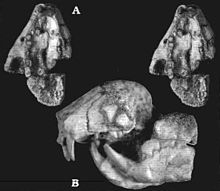Kryptobaatar
| Kryptobaatar Temporal range: Campanian-Maastrichtian
| |
|---|---|

| |
| Kryptobaatar dashzevegi | |
| Scientific classification | |
| Kingdom: | Animalia |
| Phylum: | Chordata |
| Class: | Mammalia |
| Order: | †Multituberculata |
| Family: | †Djadochtatheriidae |
| Genus: | †Kryptobaatar |
| Species | |
| |
| Synonyms | |
| |
Kryptobaatar[1]and also known as Gobibaatar[1] or Tugrigbaatar[2] is an extinct mammalian genus dating from the Upper Cretaceous Period and identified in Central Asia. This animal was a member of the extinct order of Multituberculata within the suborder Cimolodonta, and was a member of the family Djadochtatheriidae. It lived contemporaneously with some of the dinosaurs. Its skull had a length of perhaps 3 cm.
The generic name Kryptobaatar is derived from Greek κρυπτός: kruptós, "hidden," (alludes to the ventral position of infraorbital foramen) and Mongolian баатар: baatar, "hero" (alludes to the name of the capital of Mongolia, Ulan Baatar). The specific name dashzevegi is named in honour of Mongolian palaeontologist . The derivation of its synonym Gobibaatar parvus is Gobi (occurring in the Gobi Desert, Mongolia) and baatar ("a hero", the same as Kryptobaatar).[1] Another synonym Tugrigbaatar saichanensis is a generic name derived from the Toogreeg and Ulan Baatar, and a specific name derived from a Gurvan Saykhan mountain range.[3]
Species identified[]

- Kryptobaatar dashzevegi Kielan−Jaworowska, 1970. At Djadokhta Formation, , and Bayan Zag or Baruungoyot Formation, Red beds of , Mongolia. Stage: lower Campanian or Upper Cretaceous. The skull has a length of perhaps 3 cm. The front teeth look impressively sharp and not much like those of a strict vegetarian. Gobibaatar parvus Kielan−Jaworowska, 1970 and Tugrigbaatar saichanensis Kielan−Jaworowska & Dashzeveg, 1978 are now treated as synonyms of K. dashzevegi by Kielan-Jaworowska et al. (2003).[4]
- Kryptobaatar mandahuensis Smith, Guo & Sun, 2001. At Bayan Mandahu Formation, Urad Houqi Banner, Inner Mongolia, China. Based on several well-preserved skulls. This location is about the same stage as the Djadokhta Formation of Mongolia, Campanian (Upper Cretaceous).[4]
Biology[]
Kryptobaatar was a hopping species, similar to a modern Jerboa.[5] It i thought to have been a carnivory-oriented omnivore.[6][7]
Notes[]
- ^ Jump up to: a b c Kielan-Jaworowska 1970, pp. 35–49.
- ^ "Gobibaatar has page priority but was selected as the junior synonym by Kielan-Jaworowska in 1980," (McKenna & Bell, 1997)
- ^ Kielan-Jaworowska and Dashzeveg 1978, pp. 115–134.
- ^ Jump up to: a b Kielan-Jaworowska et al. 2003, pp. 273–278.
- ^ Meng Chen, Gregory Philip Wilson, A multivariate approach to infer locomotor modes in Mesozoic mammals, Article in Paleobiology 41(02) · February 2015 doi:10.1017/pab.2014.14
- ^ Wilson GP, Evans AR, Corfe IJ, Smits PD, Fortelius M, Jernvall J. 2012Adaptive radiation of multituberculate mammals before the extinction of dinosaurs. Nature 483, 457-460. (doi:10.1038/nature10880)
- ^ https://royalsocietypublishing.org/doi/10.1098/rsos.181536
References[]
- Kielan-Jaworowska Z & Hurum JH (2001), "Phylogeny and Systematics of multituberculate mammals". Paleontology 44, p. 389-429.
- McKenna MC & Bell SK, (1997), Classification of Mammals Above the Species Level. Columbia University Press.
- Kielan-Jaworowska, Zofia (1970). "New Upper Cretaceous multituberculate genera from Bayn Dzak, Gobi Desert" (PDF). Results of the Polish-Mongolian Palaeontological Expeditions, pt. II. Palaeontologica Polonica. 21: 35–49.
- Kielan−Jaworowska, Zofia; Dashzeveg, Demberlyin (1978). "New Late Cretaceous mammal locality in Mongolia and a description of a new multituberculate". Acta Palaeontologica Polonica. 23 (2).
- Kielan−Jaworowska, Zofia; Hurum, Jørn H.; Badamgarav, Demchig (2003). "An extended range of the multituberculate Kryptobaatar and distribution of mammals in the Upper Cretaceous of the Gobi Desert" (PDF). Acta Palaeontologica Polonica. 48 (2): 273–278.
- WIBLE, JOHN R.; ROUGIER, GUILLERMO W. (February 2000). "Cranial anatomy of Kryptobaatar dashzevegi (Mammalia, Multituberculata), and its bearing on the evolution of mammalian characters". Bulletin of the American Museum of Natural History. 247: 1–120. doi:10.1206/0003-0090(2000)247<0001:CAOKDM>2.0.CO;2.
- Cimolodonts
- Cretaceous mammals
- Extinct mammals of Asia
- Djadochta fauna
- Prehistoric mammal genera


